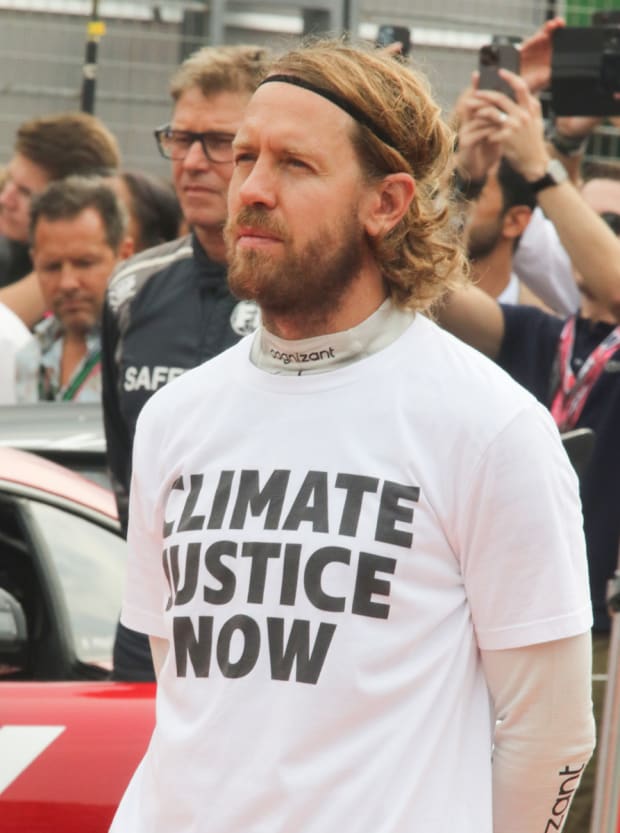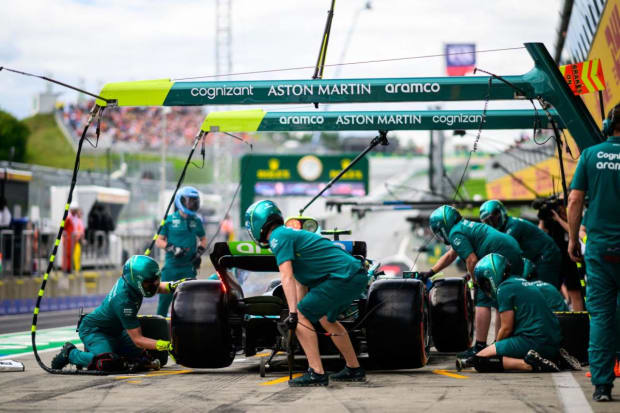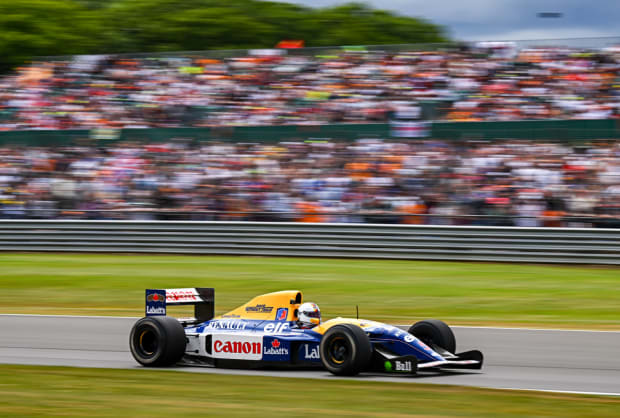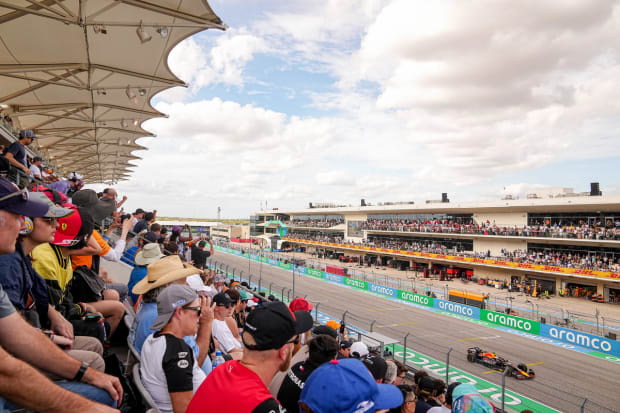Sebastian Vettel is used to being called a hypocrite.
The four-time Formula One world champion knows he is. After all, before he retired in November, he’d spent the past 16 years driving a very fast, very carbon-burning car—sponsored last season by Saudi oil giant Aramco—as part of a massive traveling circus of 20 drivers, 10 teams and thousands of staff members that hopscotches across the globe between some 20 different countries each year. By F1’s own measure, in 2019, it accounted for approximately 256,000 CO2 equivalent tonnes, about the same as a small nation.
And yet, Vettel became arguably the world’s most outspoken athlete on climate change and has been particularly critical of F1. The circuit has pledged to achieve carbon neutrality by 2030, but Vettel does not believe it is moving fast enough. Before the Miami Grand Prix last May, he sported a “Miami 2060 - 1st Grand Prix Underwater - Act Now or Swim Later” shirt. His criticisms hardly stop at F1: A month later, he described Alberta’s oil extraction as a “climate crime” on a shirt ahead of a race in Montreal. And he became the first active F1 driver to join BBC’s Question Time panel, discussing a variety of topics that also included the global energy crisis.

Arthur Thill ATPImages/Getty Images
“There’s certain things that are in my control, and certain things are not,” Vettel said on the BBC program last May. “It’s my passion to drive a car. I love it. Every time I step in the car, I love it. When I get out of the car, of course, I’m thinking as well: ‘Is this something we should do, travel the world, wasting resources?’”
Some, including Alberta’s minister of energy, are quick to point out the hypocrisy of his comments. But the 35-year-old owns the paradox, telling Sports Illustrated he started caring “too late” in life. “As much as I do believe that it will become inevitable for everyone to start seeing it,” he says, “the question is when do you start to become aware? What triggers you?”
The key question for F1 is how many people will become aware—how many fans will be triggered? At the same time that activists like Vettel are drawing increased attention to F1’s environmental impact, the sport has seen a massive boom in viewership and attendance, particularly in North America. During the U.S. Grand Prix weekend in October, for instance, approximately 440,000 fans flocked to Austin’s Circuit of the Americas. But as the sport continues to grow and reach new markets, its rise could threaten its own future.
F1 does have a slew of programs in progress aimed at achieving its goal of net zero within eight years. But Vettel says bigger questions loom. Principally: How much is F1 willing to prioritize the future over immediate profits?
There are, he says, “lots of different ways to look at many solutions in the future. But they do come at a price, and we need to be happy to give up some of the revenue and invest in … the next generation and basically the future of humanity. Because one thing that we always speak about [is] the planet, but in reality, it’s really a humanity problem.
“The planet will make it in one state or another. But the question is, are we part of it or not?”

JURE MAKOVEC/AFP/Getty Images
First: The car.
Across the globe, cities, states and countries are phasing out fossil fuel vehicles. In the U.S., California banned their sales over the coming decades (with some other states following), and the Biden Administration has proposed aggressive plans to speed the country’s transition to plug-in vehicles. It begs the question, could F1 simply go electric?
Ross Brawn, F1’s former managing director of motorsports (he retired at the end of last season), says the answer is currently no. He acknowledges the various laws have not gone unnoticed by F1: “In some ways, the introduction of electric cars made us think about how we could be relevant,” he says. But for many reasons, that solution is unlikely for F1: For starters, Formula E has exclusive rights to hold the sole full-electric championship until 2039, as approved by the governing body, Fédération Internationale de l’Automobile.
Today’s electric vehicles also could not support the current Formula One format: F1 races last anywhere from 90 minutes to two hours at speeds up to 300 kilometers (roughly 186 miles) per hour while Formula E races are around 45 minutes long with average speeds currently at approximately 173 miles per hour.
And then there’s the noise.
“The emotion of the noise and the energy of an internal combustion engine still generates a lot of passion, a lot of energy,” Brawn says. “And we’re mindful of that. That’s not the be-all and end-all, but we’re mindful of that.”
F1’s solution has been to try to make fuel power work. Thus, F1 started talking with fuel suppliers, like Aramco, about creating a 100% sustainable fuel. Currently, the vehicles are running on 90% fuel and 10% renewable ethanol, which is similar (to an extent) to the fuel we use day-to-day. (F1 fuel has a higher octane level and other minor differences given that it’s made in a laboratory where there’s “a tighter control of the blend,” Pat Symonds, F1 chief technical officer, says.)
According to Brawn, more efficient vehicles have allowed F1 to race “with two-thirds of the fuel that we used to race with.” New engine regulations, approved last summer and set to go into effect in 2026, will allow teams to use “about half of the fuel per race that we used to race with 10 years ago,” says Brawn.
The long-term goal is creating a new type of fuel that does not give off emissions. Already, there is experimentation with a biofuel that utilizes waste products that don’t affect the food cycle. Formula Two and F3 both use a single-type engine, and, beginning this season, their fuel is a 55% sustainable “drop-in” fuel. (Drop-in fuels are typically defined as renewable fuels that can be pumped through our existing gas-station infrastructure.) Brawn has dreams of an F1-engineered biofuel making its way to ordinary drivers.
“It’s a fuel that could use the logistics system that exists already in the world so we wouldn’t have to build thousands of charging stations,” Brawn says. “We’ve got petrol stations on every corner of the street.”
Of course, it’s key to note that race car emissions account for less than 1% of F1’s total emissions. But environmental experts have argued the influence and example set by hugely popular sports organizations is their most substantial impact on the environment. As Brawn puts it, “The message from the race car is almost 100% of what we do.”
Symbolism aside, F1 officials believe the development of biofuels could help reduce the impact of the circuit’s travel logistics—all the trucks, ships, airplanes and more, which account for two-thirds of the circuit’s carbon footprint. Some teams are already testing this route. Mercedes reported an 89% reduction in its CO2 land freight emissions during a biofuel truck trial the team undertook among three European races last year. Their 16 trucks used hydrotreated vegetable oil biofuel, which is essentially a 100% renewable fossil-fuel-free product that comes from vegetable and waste oils as well as fats.
This comes after Mercedes became the first global sports team to invest in sustainable aviation fuel. According to the team, SAF will help it achieve nearly a 50% reduction in its air travel footprint. Flights alone account for more than a quarter of its projected carbon footprint. (In general, SAF remains expensive and scarce.)
IndyCar has this season the first American motorsports series to use 100% renewable fuel, and series officials estimate there will be “at least 60% greenhouse gas emissions reduction compared to fossil-based gasoline” with this new fuel. Shell is also one of the fuel suppliers for two F1 teams—Ferrari and Haas. The Prancing Horse’s current fuel has up to 10% second-generation bioethanol, made from sugarcane waste.
Vettel feels sustainable fuel is “a bridging tool to the future” given the rise of electric cars—but he knows it’s an expensive bridge. When he drove Nigel Mansell’s 1992 Williams-Renault during the British Grand Prix weekend last July, Vettel opted for a zero carbon dioxide fuel, meaning one that doesn’t add CO2 to the environment. However, he paid €5.95 per liter (or $22.52 per gallon) for the demonstration.
“If F1 can be a platform to develop these sustainable fuels, make them more potent and drive the cost down in the making, then that will be a great purpose for Formula One,” Vettel says. “Otherwise, I see that [with] our sport, like other sports and other businesses, people will start asking the question, ‘What's the point?’ And rightly so in a world that will get more and more difficult to live in.”

Clive Mason/Getty Images
There are other changes happening at F1. You can start at the tracks: Vettel stood side by side with COTA CEO Bobby Epstein ahead of the U.S. Grand Prix weekend, planting a tree alongside the circuit. In honor of the German’s looming retirement, the track pledged to plant a total of 296 trees (one in honor of each of his career starts up to then). The first 20 saplings were planted on the campus in Vettel Grove, while the rest will help with floodplain restoration at a park close to COTA.
Planting trees is the type of one-time step that, when not backed up by deeper action, is often criticized by experts as greenwashing. While Austin has taken additional steps, like replacing single-use plastic cups with aluminum ones and adding water stations, some tracks have exhibited deeper commitment. Paul Ricard in France and Circuit Gilles Villeneuve in Montreal have installed solar panels, for instance. Meanwhile, Spain’s Circuit de Barcelona-Catalunya and Bahrain’s Sakhir International Circuit utilize 100% renewable energy. The 2022 Dutch GP saw 99% of its general-admission-ticket holders opt for public transportation or bike or walk to the track. Additionally, the Dutch GP used alternative fuels and installed a smart power grid, leading to an 80% reduction in CO2 emissions.
Circuits like these reflect the push that’s also occurring within F1, whose offices are run with 100% renewable energy. F1 has also eliminated single-use plastic in the paddock and promoted reusable water bottles. There’s a push to repurpose, reuse and recycle race materials, and leftover food is being donated to local communities.
In fact, when it comes to energy use directly under its control, “F1 is actually doing an amazing job,” says Maddy Orr, a sports ecologist who runs Loughborough University’s master’s program on sustainable sports business. Things get more complicated, though, she says, when you start talking about all of the other emissions related to F1’s operations—particularly the ones outside its direct control. That includes everything from the production of car parts to fan travel to events to how F1’s 10 teams and their equipment traverse the globe.
That last example is by far the most important: Travel logistics account for two-thirds of F1’s carbon footprint. And here, the circuit has yet to put its money where its mouth is. Although the sport said it wanted to better group the calendar regionally to reduce travel, the placement of the 23 races in 2023 slate is hardly mileage efficient.
For example, races in Azerbaijan and Miami are back-to-back, but nearly 7,000 miles apart. In between Miami in May and Austin in October, there are stops across Europe, Asia and the Middle East.
Ellen Jones, F1’s head of sustainability, says it can be difficult to get race promoters to change their dates. After all, individual tracks may be less interested in helping the environment than finding the optimal time for their event.
But, at the end of the day, F1 is the entity that makes the call, says Orr. “They’re the ones juggling that Jenga of getting it right. And so I think it’s on the rightsholder to not sign the contract until it makes sense.”
In other words, if F1 is serious about achieving its carbon neutrality goals, it’s going to have to exercise its leverage over tracks, and not the other way around. That may cost the circuit money, but the question is how serious it is about achieving its environmental goals. Orr says:
“There’s probably a lot of little nitpicky things I’m not considering, but if the planet is your priority, those nitpicky things become less important. And you can do it.” Orr cites moments like the COVID-19 global pandemic as an example of when changes were rapidly made.
Jones concedes reducing F1’s travel footprint “is integral to us achieving net zero by 2030. It’s critical for the future of our sport.”
She says it will be a process that likely takes place over years as track contracts come up for renewal, not all at once. “As the calendar shifts every year, hopefully what we will be doing is making those changes to be more and more efficient in our travels,” Jones says. “But it will not be an easy one-size-fits-all solution. We will keep talking about it and keep taking action.”

BEN STANSALL/AFP/Getty Images
Alfa Romeo driver Valtteri Bottas knows what it’s like to experience a pristine environment. Finland is known for its air and water quality, especially the city of Lahti, where he grew up nearby. When the city was dubbed a Green Capital in 2021 because of its sustainability efforts, Bottas was named an ambassador for the project. While speaking out on climate change last fall, he announced he was launching a new bicycle race there, set for June. But as an F1 driver, he acknowledges the carbon footprint his job has, especially in terms of travel. He says he’s careful to make “simple choices” such as biking or walking.
Traveling the world made him appreciate his hometown more. The air quality in some cities shocked him, particularly how it “affects your health and breathing in [for] just like one week.” Bottas says he has become more aware of this crisis within the past couple of years as more people spoke about climate change, and says it’s important to address this topic “for the future generations.”
It all begs the question—can F1 truly achieve net carbon zero by 2030? Paolo Taticchi, a professor in strategy and sustainability as well as the deputy director at UCL School of Management, isn’t “too concerned” about it being just a tagline given the sport’s sustainability strategy.
The Sustainable Motorsport Index is a measuring stick created by Enovation Consulting, a sustainability-focused firm, drawing on criteria and goals set out by the UN and others. It studies not just tracks (the Sustainable Circuits Index) but also the championships (Sustainable Championships Index) through data that is publicly disclosed. Taticchi helped devise the methodology that looks at how these tracks and championships engaged with sustainability.
As expected, Formula E was the most sustainable in the championship-specific index, but F1 scored second. What surprised Taticchi, though, was the lack of reporting among other larger championships and how some of them did not have a structured plan in place. He felt the motorsports sector was late to sustainability compared to others.
Given the amount of transparency needed for net carbon zero by 2030 to become a trusted reality, Vettel believes F1 needs an independent body monitoring and governing its journey. Taticchi thinks existing governing structures are enough, but when it comes to disclosure, standards could be created to encourage and reinforce transparency.
For F1 to achieve its goals, collaboration and transparency will be key, both of which could be difficult in a highly competitive environment (most obviously between different teams). Jones says, “How do we make sure that competitive nature is working for us?”
So what will the F1 of the future look like? It’s hard to say now. Conceivably, Taticchi says, it could continue using fossil fuels in cars but reduce other, larger (albeit less symbolic) parts of its footprint. “They may use fossil fuels forever in Formula One, and that might be fine if they find ways to kind of offset the impact of the use of these fuels,” he says.
“They need to change,” he continues, but adds he believes “they’re gonna find a way to do it.”
Orr raises other questions about the future of the sport, noting that with cities and countries taking hard stances on the types of vehicles allowed, F1 could run into a speed bump in the not-too-distant future.
“There are a few cities on the Formula One circuit that already have plans to not allow fuel-based vehicles in their downtown areas by 2030. Montreal is one of them. If that happens, can they even host Formula One anymore?”

Erick W. Rasco/Sports Illustrated
Formula One drivers stood in two straight lines, facing one another, at the Yas Marina Circuit in November to bid farewell to the retiring Vettel. With smiles etched on each competitor’s face, they shook Vettel’s hand as he walked through the guard of honor. But while the drivers had on their normal race-day gear, the German went a different route.
The four-time world champion sported a black T-shirt with Earth on it and the word “invitation” below. He revealed during an Instagram Live after the race—in which he finished 10th—that being confronted with the beginning of life (his children being born) and the end of life (the death of his father-in-law) within a few years “made me reflect [on] my life and the future that is ahead of us and the world we live in and realizing the privilege that I have living the life that I do.”
He began looking at ways to alter his habits, such as how he traveled to races. Vettel stopped traveling on private jets and looked at his nutrition, which energy sources he used and what his purchasing habits were. He added on the IG Live, “I don’t want to point fingers at you or anybody [and] say this is what you should do, but I really try to speak also to the other drivers to emphasize that we are in this unique position to have an impact on our planet’s climate. We are backs to the wall. It’s time to change. It’s time to reconsider our actions, and we must think of future generations going forward.”
Vettel says when it comes to the climate crisis, he feels there is “not that much interest” among the other drivers. But, he also understands why, to an extent. He says, “Generally, F1 is quite far away from the problems the world is facing because at the [moment]. Don’t get me wrong; it sounds maybe a bit weird, but we can afford to financially. That doesn’t make it right, though.
“In the end,” Vettel says, “it’s all nice to set these agreements and these targets, but what are the consequences if we don’t meet them?”







